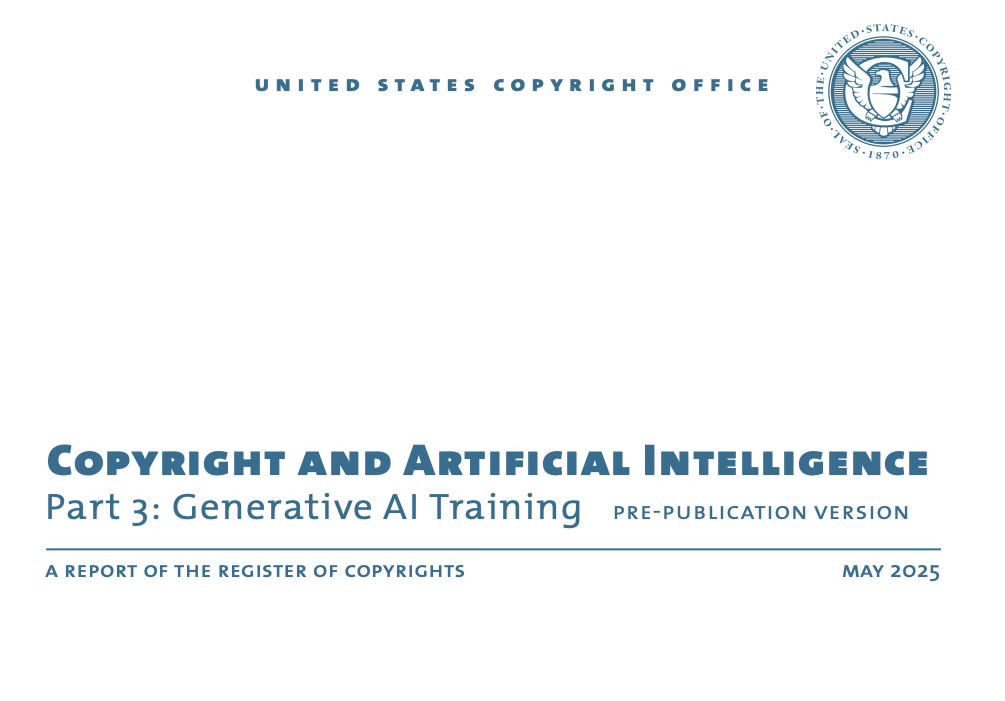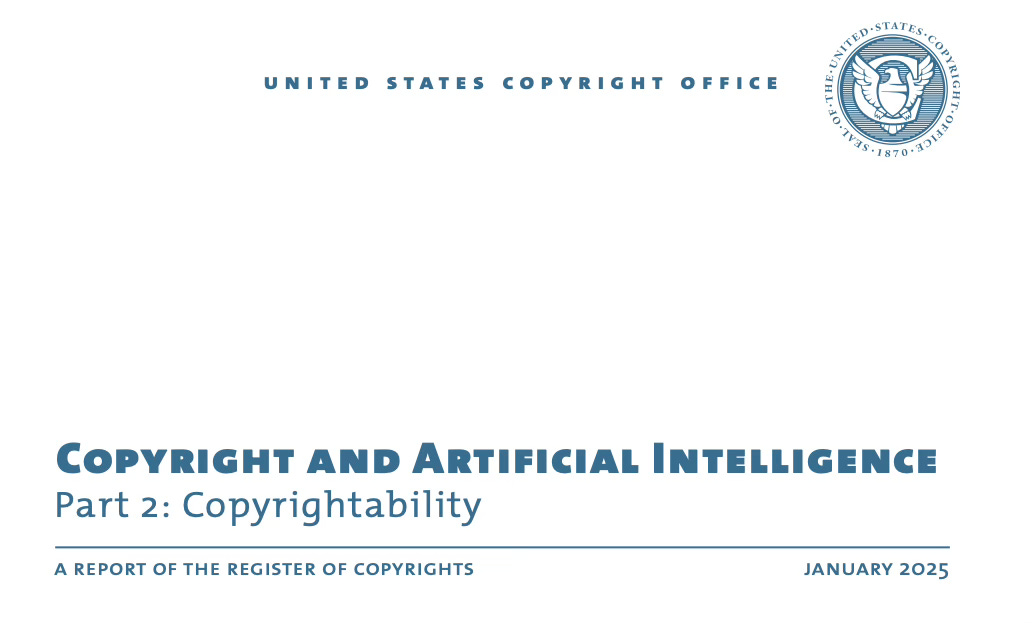- Pascal's Chatbot Q&As
- Posts
- GPT-4o: US Copyright Office acknowledges the existence of voluntary licensing arrangements in certain sectors, including news and academic publishing, which could serve as models for broader adoption.
GPT-4o: US Copyright Office acknowledges the existence of voluntary licensing arrangements in certain sectors, including news and academic publishing, which could serve as models for broader adoption.
The report stresses that not all uses of copyrighted works for AI training will qualify as fair use, despite the transformative potential of generative AI.
Generative AI Training and Copyright Analysis
by ChatGPT-4o
The U.S. Copyright Office’s Copyright and Artificial Intelligence, Part 3: Generative AI Training report, released in May 2025, provides a comprehensive examination of the intersection between generative AI technologies and copyright law. The report responds to congressional inquiries and stakeholder concerns regarding the use of copyrighted works in AI training, focusing on issues like prima facie infringement, fair use, and licensing. This analysis highlights key findings for scholarly publishers, AI developers, and regulators, emphasizing the implications for Fair Use and emerging licensing models.
Key Findings for Scholarly Publishers
Market Displacement and Financial Harm
Generative AI training can harm the market for copyrighted works by enabling the production of competing content without proper compensation. This can reduce sales, dilute brand value, and undermine licensing revenue. For example, the report notes that AI outputs can substitute for or mimic the expressive style of original works, impacting their commercial value.
Publishers have expressed concerns about “market dilution,” where AI-generated outputs, even if not identical to the original works, can reduce demand for human-created content, leading to significant financial losses.
The risk is particularly acute for scholarly publishers, whose business models depend heavily on licensing revenues and institutional subscriptions.
Voluntary Licensing as a Potential Solution
The report acknowledges the existence of voluntary licensing arrangements in certain sectors, including news and academic publishing, which could serve as models for broader adoption. For instance, companies like Wiley and Taylor & Francis have reportedly entered multi-million-dollar licensing deals to provide academic texts for AI training.
However, the feasibility of scaling such licensing systems remains uncertain, as it may be prohibitively expensive and logistically challenging to license the vast volume of data needed for effective AI training.
Data Collection and Content Ownership
Publishers remain concerned about the use of copyrighted texts without explicit permission, especially when AI developers scrape publicly accessible content or rely on mass digitization without adequate copyright controls.
The report highlights the risk of unintentional infringement, as copyrighted content is often included in training datasets without clear provenance or licensing agreements.
Key Findings for AI Developers
Challenges of Fair Use Defense
The report stresses that not all uses of copyrighted works for AI training will qualify as fair use, despite the transformative potential of generative AI. The first and fourth factors—purpose and character of the use, and market impact—are likely to weigh heavily against fair use in many cases.
The Office explicitly rejects the analogy between human learning and AI training, arguing that AI systems can create near-perfect reproductions at superhuman scale, which poses a distinct copyright risk.
Courts are expected to scrutinize the commercial nature of AI training, as well as the extent to which outputs substitute for the original works, potentially undermining the value of those works.
Technical Safeguards and Data Provenance
AI developers are encouraged to implement more robust safeguards to prevent unintended copying of copyrighted works, including data provenance tracking and output filtering.
The report notes that developers must consider the ethical and legal implications of training models on copyrighted material, especially if they cannot ensure that the resulting outputs are sufficiently distinct from the original works.
Implications for Model Deployment
Generative models trained on copyrighted data may face legal challenges even if the outputs are not directly infringing, due to the complex and evolving nature of copyright law.
Developers are urged to explore alternative data sources, such as public domain works or licensed datasets, to reduce the risk of copyright infringement.
Key Findings for Regulators
Balancing Innovation with Copyright Protection
The report underscores the need for balanced regulation that protects copyright holders while fostering AI innovation. It warns against over-reliance on the fair use doctrine to justify AI training, given the potentially devastating impact on creative industries.
Regulators are encouraged to consider compulsory or collective licensing schemes as alternatives to unlicensed training, providing clearer pathways for compensating rights holders.
International Approaches and Harmonization
The report highlights ongoing international efforts to address AI and copyright, including the EU’s Copyright Directive and Japan’s recent guidelines on AI training. These approaches vary widely, reflecting different national priorities and legal frameworks.
U.S. policymakers are advised to monitor these developments to ensure that domestic regulations align with global standards and promote fair competition in the AI sector.
Fair Use Analysis
The report provides a detailed analysis of the fair use doctrine, emphasizing that courts must weigh each of the four statutory factors on a case-by-case basis. Key takeaways include:
Purpose and Character of the Use: Commercial uses, particularly those that directly compete with original works, are less likely to qualify as fair use.
Nature of the Copyrighted Work: Creative works are afforded stronger protections than factual or functional works, making fair use claims more challenging for AI developers.
Amount and Substantiality: Using large volumes of copyrighted material, especially entire works, weighs against fair use.
Market Impact: The potential for market harm is a critical factor, particularly when the outputs can substitute for the original works.
Conclusion
The Copyright Office’s report presents a nuanced view of the challenges facing the creative industries, AI developers, and regulators as they navigate the rapidly evolving landscape of generative AI. The report’s cautious stance on fair use suggests that more concrete licensing frameworks may be necessary to ensure that copyright law remains effective in the AI era. For scholarly publishers, the stakes are particularly high, given the potential for market disruption and financial harm if unlicensed AI training becomes widespread.
Future discussions are likely to focus on developing new licensing models, improving transparency in AI training, and ensuring that creative industries are fairly compensated for their contributions to AI technologies.

·
30 JAN

"The Human Touch in an AI Age: Analyzing the U.S. Copyright Office's Framework for AI-Generated Content"